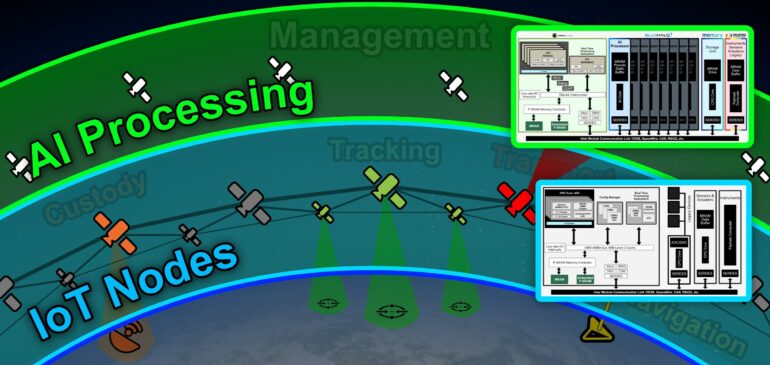TL;DR:
- Avalanche Technology’s white paper explores the implementation of AI computing in space.
- The Space Race has witnessed a resurgence, driven by the need for advanced communication, navigation, and scientific exploration.
- Avalanche introduces a novel Space-IoT architecture addressing challenges like unreliable power, data storage, and radiation.
- Unlike terrestrial approaches, space requires a more robust and streamlined hardware architecture.
- Lessons from historical endeavors are incorporated into this innovative solution.
- Collaborations with key partners, including Blue Halo, Trusted Semiconductor, and Mercury Systems, are highlighted.
- The Space-IoT architecture exhibits scalability and supports NASA’s 2028 Moon Gateway launch.
Main AI News:
Avalanche Technology, a pioneer in the realm of next-generation MRAM technology, has unveiled a groundbreaking vision for the integration of artificial intelligence (AI) computing in the domain of space. Their newly released white paper, titled “AI Computing in Space: A New Space-IoT Architecture to Tackle the Processor Scaling Challenge,” explores the imperative need for a transformative approach to scaling processing and cloud architectures tailored specifically for space.
In what can be termed as Industry 5.0, the Space Race has experienced a remarkable resurgence. Decades of tepid attention to space-based technologies have given way to a meteoric surge in investment, driven by an insatiable demand for ubiquitous broadband communication, pinpoint-accurate navigation, advanced weather forecasting, scientific exploration, enhanced reconnaissance capabilities, and a collective determination to establish sustainable habitats beyond Earth.
The proliferation of satellites, featuring augmented constellations, coupled with an increase in sensors per satellite and improved sensor resolutions, has inundated us with vast celestial datasets that necessitate efficient storage and real-time analysis. To enable satellites and spacecraft to make instantaneous autonomous decisions, particularly for defense-related missions, they must possess the highest echelons of artificial intelligence—situational awareness—that can operate independently in orbit without reliance on ground-based data analysis.
This illuminating white paper delves into several critical aspects, including drawing insights from historical paradigms and introducing a novel Space-Internet of Things architecture that offers an immediate solution to three formidable challenges in space:
- Unreliable power sources.
- The incapacity to store an unlimited volume of data from IoT satellite nodes.
- The pernicious effects of radiation.
In contrast to terrestrial high-performance processing frameworks that tend to augment computing power linearly, the distinctive conditions of space necessitate a paradigm shift towards a more resilient yet streamlined, SWaP-optimized (Size, Weight, and Power) hardware architecture capable of addressing enduring mission requirements. This white paper meticulously explores:
- Why conventional approaches to scaling processing and cloud architectures are ill-suited for the space domain.
- Valuable lessons derived from historical endeavors.
- A compelling solution that defies the unyielding challenges of space.
Danny Sabour, Avalanche’s Vice President of Marketing and Business Development, emphasizes the company’s unwavering commitment to addressing space-specific challenges. He stated, “This new white paper extends Avalanche’s legacy of solving space-related hurdles. We previously demonstrated how to enable Multi-Mission Boot Capability and design robust space-based data centers. Now, we complete the puzzle of Orbital Internet by introducing a new architecture, available today, for the implementation of AI computing in space.“
The white paper meticulously elucidates how the innovative Space-IoT big data processing architecture exhibits scalability, charting a course from Earth to the Moon and onward to Mars. Leveraging existing technology, this architecture is poised to be deployed in time to support NASA’s planned 2028 Moon Gateway launch.
Avalanche’s revolutionary concept introduces the concept of “Pseudo Static” data, a key element in facilitating scalable high-performance processing in the space environment. Additionally, the paper underscores the significance of collaborative product development partnerships, including those with Blue Halo, Trusted Semiconductor, and Mercury Systems. Future iterations of the Avalanche Space-IoT architecture are poised to further reduce power consumption and enhance parallel processing capabilities, all while maintaining an unswerving commitment to the same software framework—especially vital for parallel processing in space.
Conclusion:
Avalanche’s Space-IoT Architecture represents a pivotal step towards revolutionizing space computing. By addressing the unique challenges of space and leveraging historical insights, Avalanche is well-positioned to play a significant role in shaping the future of the space technology market. This innovative approach, coupled with strategic partnerships, underscores their commitment to advancing space exploration and satellite technology.

